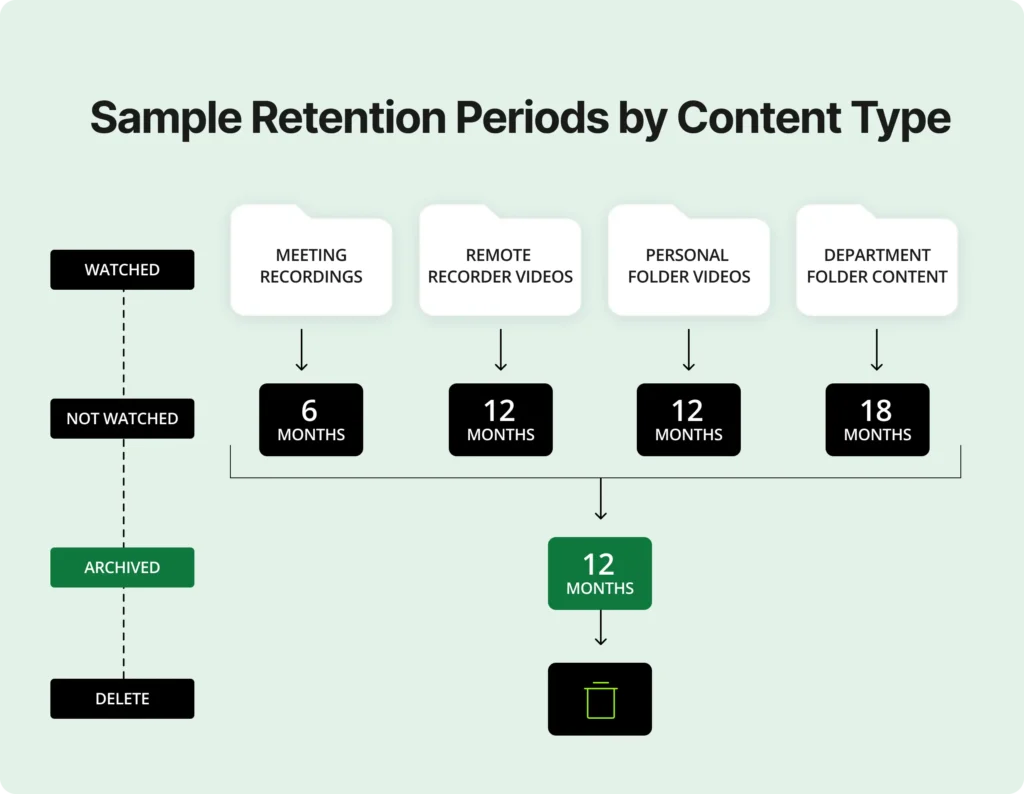- Academic Technology
Content Retention Demystified: Strategies for Smarter Video Storage with Panopto

As virtual, hybrid, and asynchronous learning continues to expand, universities and other higher education institutions are creating and storing more video content than ever. Professors record new lectures and course materials, administrators create presentations for meetings, and students upload videos for class assignments and extracurricular activities. This volume of video quickly adds up, creating a vast library within your LMS or video content management system.
Over time, it is not uncommon for institutions to amass video libraries containing tens of thousands of videos, up to hundreds of thousands of videos. When evaluating libraries of this size, administrators often ask, do we need to keep all this video?
Preserving irrelevant or outdated videos isn’t just a logistical challenge that clutters your learning ecosystem. It also creates genuine risks for your university while imposing extra storage costs that needlessly drain your budget.
To ensure a consistent, relevant, and high-quality student experience, instructional technologists and administrators must adopt a smart content hygiene strategy that archives and deletes unwatched or irrelevant videos.
What is content hygiene?
In general terms, content hygiene refers to the process of evaluating the content on a website or platform to ensure that it’s relevant, updated, and useful. The idea is simple: just as physical clutter can impinge on the comfort and practicality of a home or workplace, digital clutter can detract from the usefulness of an online space.
In the context of a higher education institution with a vast video lecture library, content hygiene involves establishing a content retention policy that hides, archives or deletes older videos that no longer serve their original purpose. Your university’s library probably includes thousands of videos that haven’t been watched in years – class materials that have since been replaced, video presentations from students who have graduated, and tutorials about policies that no longer exist. You’ll create a more functional video library by ditching the digital dead weight.
4 reasons universities should establish a video content retention policy
Content hygiene is about more than mere tidiness. Yes, purging your library of excess videos will make the entire digital space feel cleaner, but it also comes with significant educational, legal, and financial benefits. Practicing content hygiene by implementing and sustaining a video content retention policy is an institutional best practice in today’s digital learning environment for many reasons.
1. Maintain search quality
Proper content hygiene is essential for achieving highly relevant search results within Panopto’s video libraries. Features like automatic speech recognition (ASR), optical character recognition (OCR), and slide indexing are designed to capture every spoken word and onscreen detail, making your videos fully searchable. However, when libraries are overwhelmed with obsolete and irrelevant content, these intelligent search tools must process excessive data, leading to cluttered results. By implementing content retention policies that archive or delete outdated videos, institutions can streamline their video collections, ensuring that search queries surface the most relevant, current, and useful material. This focused approach enhances both the speed and reliability of searches, allowing users to find exactly what they need without sifting through unnecessary digital clutter.
2. Enforce the rigorous quality standards your students and faculty expect
Just as you wouldn’t keep a years-old syllabus or a textbook with outdated information, all video lectures and recorded courses should meet the same rigorous accuracy, relevance, and quality standards of your institution.
Unlike static course materials, a key benefit of video lectures and recorded courses is the ability to quickly edit and update material as information changes. Preserving outdated videos defeats the flexibility of the medium and puts the burden on professors and administrators to manage obsolete content.
A content retention policy makes the lives of faculty and staff easier by reducing time and effort spent navigating outdated files and improving the overall quality of an institution’s lecture library.
3. Responsibly and transparently reduce risks posed by outdated materials
Obsolete data creates both educational and legal risks for institutions. Imagine a student happening upon an old lecture or outdated video explaining a university policy that has since changed. This student could make irreparable mistakes based on inaccurate information that was left within your LMS or video management system.
Moreover, preserving old content heightens potential legal risks and complexities for your institution. Requests for information, whether from a lawsuit or a FOIA request, require universities to dig through their digital archives to surface data that they may not even realize they have.
A clearly defined content retention policy ensures that institutions are responsibly maintaining relevant records with transparent guidelines that mitigate legal risks.
4. Optimize budget in the face of increasing cloud storage costs
It’s no secret that the cost of securing and scaling cloud storage is on the rise. In a world where every saved video comes with a price, there’s no sense in paying to store outdated content.
The “keep everything forever” approach is unsustainable for the budget-savvy administrator or technologist. Rather than paying rent for thousands of unwatched videos, a policy that outlines content retention steps and best practices helps you reduce unnecessary spending while ensuring essential content is always available.
Refrigerate vs. Freeze:
Using archival storage for optimal video management
Now that you understand the value of content hygiene, where do you start?
Cleaning up your content library and deleting thousands of old videos might sound like an intimidating undertaking – but it doesn’t have to be. With the right policies in place, you can create systems that automatically archive or delete unwatched videos while protecting the materials that faculty and administrators value.
The best content hygiene strategies are flexible by design, giving administrators and professors the agency to make their own decisions about the videos under their purview. Many institutions provide this essential flexibility by implementing an archival storage policy that divides your content into “storage” and “archive” categories.

- The “storage” category captures relevant, updated, frequently watched videos like those in your LMS, CMS, blog, or wiki for easy, instant access. Think of this as your refrigerator of everyday essentials like eggs or bread.
- The “archive” category preserves important videos that you might not need every day or even every semester. Think of this as your freezer, where you can defrost leftovers from time to time. Videos are still readily available but may take several more minutes to retrieve. Archiving helps free up space in your content refrigerator, ensuring that primary storage is always accurate and fresh.
Archival storage gives faculty and administration a way to remove videos from the general library without deleting them altogether. It also works well with automated systems that archive and delete data on their own. When unviewed videos are sent automatically into archival storage, people will have a chance to notice their absence from the primary storage library and retrieve them before they’re deleted. This tiered approach prevents mishaps and increases support for content hygiene as a practice within the university.
How to implement an effective content retention strategy
Content hygiene doesn’t take place in a silo. As technologists and administrators, be sure to communicate with primary stakeholders to develop a policy that everyone can support in order to help your university mitigate risks, save money, and better serve the student body. By adopting a set of best practices around implementation, you can build a culture of content hygiene that benefits your entire institution.
Steps to Creating a Content Retention Policy

- Engage Stakeholders – The first step in implementing an effective content retention strategy is to engage and educate key stakeholders. This involves identifying individuals or groups within the institution, such as leadership, IT, faculty, and governance teams, who play a role in managing content. Clear communication is essential to gain their support and mitigate resistance. By presenting the goals of the initiative, the problems it solves, and its benefits, alongside compelling data, stakeholders can better understand the value of content hygiene. Additionally, addressing their feedback and concerns fosters collaboration and helps build a comprehensive strategy that aligns with their needs, ensuring a smoother implementation process.
- Policy Design – The second step in implementing a content retention strategy is creating a plan that reflects stakeholder input. Employing retention tools that allow bulk management of content helps scale the process efficiently while still offering flexibility for individual departmental needs. The strategy should avoid overly complicated policies, ensuring stakeholders have clarity and room to manage their content without confusion. Additionally, creating designated archive folders for materials ensures that sensitive or valued content remains protected, giving stakeholders confidence and control throughout the process. Finally, refer to the 6 questions to ask when designing a content retention policy framework below:
- Retention Periods: How long should videos (e.g., meeting recordings, Remote Recorder videos, personal folder videos) be stored if they’re not being watched?
- Content Type: Should this duration vary based on the type of video, its source, or its age?
- Archiving and Deletion: How long should videos remain in the archive before they’re permanently deleted?
- Retention Triggers: After an item is flagged for retention action, how long should it take before it is archived or deleted?
- Departmental Requirements: Do different departments have unique retention requirements that need to be addressed?
- Administrator Oversight: Should administrators be required to confirm retention actions before they are executed?
- Impact Modeling – Content retention impact modeling is a powerful tool that enables system administrators to assess the potential effects of content retention policies before implementation. By generating detailed reports, admins can see the amount of content to be archived or deleted, ensuring informed decision-making and minimizing unexpected outcomes. Additionally, multiple impact models can be run to cover a series of retention scenarios, ultimately helping to refine the policy further.
- Policy Implementation – The final step in implementing a content retention strategy focuses on preparing faculty, administrators, and students for the impending changes. This requires clear and proactive communication to prevent surprises, confusion, or resistance. A comprehensive communication plan should outline what content will be archived or deleted and provide training materials and updates across platforms like the LMS and video management systems. By explaining the changes thoroughly and giving individuals time to adjust their workflows, institutions can foster acceptance and ensure a smooth transition to the new policy.
Putting Your Content Retention Policy into Practice in Panopto
Now we’ve covered key benefits and steps to maintain content hygiene, let’s look at an example content retention policy. The specific scope and parameters below represent a relatively common policy that we see here at Panopto.
Purpose
The goal of this policy is to manage video content efficiently within Panopto by defining clear retention and archiving parameters. This ensures optimal storage usage, compliance with organizational requirements, and access to relevant content while removing outdated material.
Scope
This policy applies to all types of video content within the Panopto library, including but not limited to:
- Meeting recordings
- Remote Recorder videos
- Personal folder content
- Departmental and organizational videos
Retention Parameters

Aging Rules
If a video exceeds 3 years from its creation date and has not been watched in the past 12 months, it is flagged for archiving regardless of content type.
Archiving Rules
- Archived videos will be stored for 12 additional months. After this period in the archive, the content will be permanently deleted.
- Archived videos are moved out of the stored hours quota, reducing overall storage demand while still allowing retrieval within the archive retention period.
Specific Criteria by Content Type
- Meeting Recordings – Rules related to meeting integrations (e.g., Zoom, Microsoft Teams) are stricter due to the high volume these generate. These recordings are archived after 6 months if not accessed.
- Personal Folders (My Folders) – Content in My Folders is treated differently from departmental folders. Videos here are archived after 12 months of inactivity to reduce unused personal content clutter.
- Old Content Across All Folders – Videos more than 3 years old with no views over the past year are archived ahead of standard retention rules to eliminate stale content.
- Administrator Oversight – Administrators are required to confirm retention actions for sensitive or critical folders before deployment.
Policy Review and Updates
This policy will be reviewed bi-annually to ensure compliance with the organization’s changing requirements, technology updates in Panopto, and feedback from departments.



